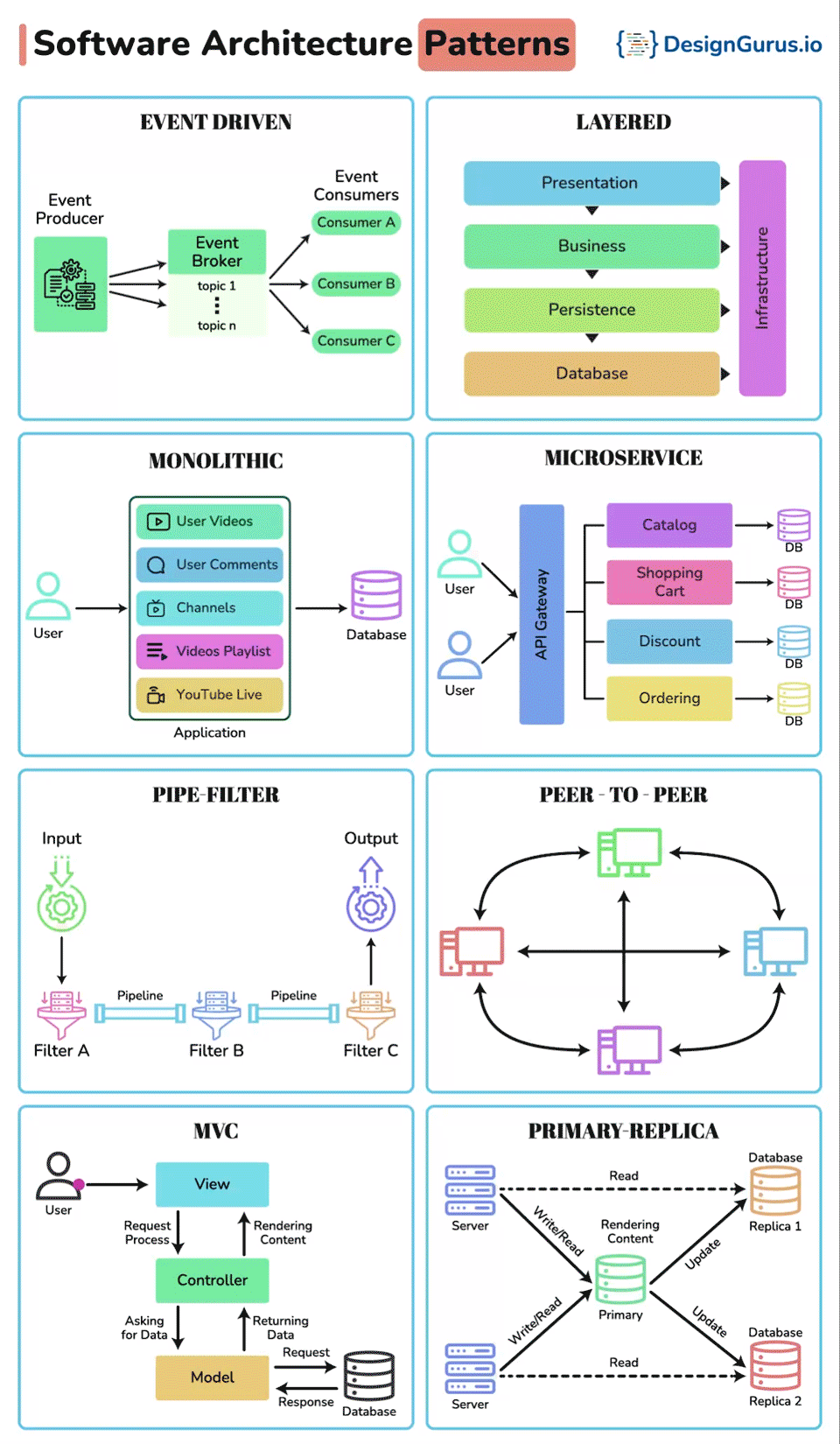Quick Summary: Software architecture serves as the blueprint for your software application. It defines the overall structure, components, and interactions that bring your program to life. Choosing the right architectural patterns is crucial for building secure, maintainable, and scalable software systems.
This blog post delves into 10 essential software architecture patterns that every developer should be familiar with. Understanding these patterns will empower you to make informed decisions during the development process, leading to more robust and successful software applications.
1. Layered Pattern
Imagine a cake! The Layered Pattern structures your software system like a delicious cake, with distinct layers that perform specific tasks. The presentation layer handles user interface elements, the business logic layer manages core functionalities, and the data access layer interacts with databases or other data sources.

- Benefits: Promotes modularity, simplifies development, and enhances maintainability.
- Use Cases: Ideal for web applications, enterprise software, and applications with well-defined layers of functionality.
2. Client-Server Pattern
This pattern separates the application into two sides: the client (user interface) and the server (data processing logic). The client interacts with the server through a network connection, requesting and receiving data. Think of it like a waiter taking your order (client request) to the kitchen (server) and bringing back your food (server response).
- Benefits: Improves scalability, enhances security (sensitive data resides on the server), and promotes better resource management.
- Use Cases: Widely used in web applications, distributed systems, and database applications.
3. Event-Driven Pattern
This pattern emphasizes communication through events! Components within the system communicate by publishing and subscribing to events. When an event occurs (e.g., a user login), it triggers a response from other components that are subscribed to that event. Imagine a fire alarm system! When smoke is detected (event), the alarm sounds (component response).
- Benefits: Loose coupling between components, promotes scalability and flexibility, and simplifies development of real-time applications.
- Use Cases: Ideal for real-time applications, chat applications, and asynchronous communication systems.
4. Microservices Pattern
Think of microservices as a team of specialists! This pattern breaks down the application into small, independent services that communicate with each other through APIs. Each service performs a specific task, promoting modularity and independent development. Imagine a restaurant kitchen with separate stations for appetizers, entrees, and desserts.
- Benefits: Increased agility, improved scalability, and easier maintenance and deployment.
- Use Cases: Complex applications, e-commerce platforms, and applications requiring frequent updates.
5. Model-View-Controller (MVC) Pattern
The MVC pattern separates an application into three parts: the Model (data), the View (user interface), and the Controller (handles user interactions). This promotes separation of concerns, making the code more maintainable and easier to test. Think of MVC as separating actors in a play! The Model provides the script (data), the View acts it out (user interface), and the Controller directs the actors (handles interactions).
- Benefits: Improves code reusability, simplifies development and testing, and promotes clean separation of concerns.
- Use Cases: Web applications, desktop applications, and mobile applications.
6. N-Tier Pattern
This pattern organizes an application into horizontal layers, with each layer performing a specific function (presentation, business logic, data access). It offers more flexibility compared to the Layered Pattern by allowing for multiple tiers within each layer. Think of it as a multi-story building, with each floor representing a tier with potentially multiple sections.
- Benefits: Improves scalability, promotes modularity, and simplifies maintenance.
- Use Cases: Complex enterprise applications, database-centric applications, and applications requiring clear separation of concerns across multiple layers.
7. Domain-Driven Design (DDD)
DDD focuses on modeling the core domain concepts of your application. It emphasizes a ubiquitous language, where both developers and business stakeholders share a common understanding of the domain terminology. Imagine building a house! DDD ensures everyone, from architects to construction workers, understands terms like “foundation” and “roof” in the same way.
- Benefits: Improves communication between developers and stakeholders, reduces complexity in complex domains, and fosters a more maintainable codebase.
- Use Cases: Complex enterprise applications, domain-specific software, and applications where clear domain modeling is crucial.
8. Message Queue Pattern
This pattern utilizes a queue to decouple communication between components. Components send messages to the queue, and other components can asynchronously process them. Think of it as a mailbox! Messages are dropped off (sent to the queue) and retrieved (processed) at a convenient time.
- Benefits: Improves scalability and fault tolerance (messages are processed even if a recipient is unavailable), and allows for asynchronous communication.
- Use Cases: Microservices architectures, real-time applications, and systems handling high volumes of messages.
9. API Gateway Pattern
Imagine a front door to your house! The API Gateway pattern acts as a single entry point for all API requests coming into your application. It routes requests to the appropriate microservices or backend functionalities, promoting security and centralized management.
- Benefits: Enhances security (centralized access control), simplifies API management, and improves scalability.
- Use Cases: Microservices architectures, API-driven development, and applications requiring a single entry point for external requests.
10. Adapter Pattern
This pattern allows incompatible interfaces to work together. It acts as a translator, converting data or operations from one format to another, enabling communication between disparate systems. Think of it like a plug adapter that allows you to use a device from one country in another with a different electrical outlet.
- Benefits: Improves code reusability, promotes loose coupling between components, and allows for integration with external systems.
- Use Cases: Legacy system integration, data exchange between heterogeneous systems, and applications requiring communication with diverse interfaces.
Conclusion
By understanding and applying these 10 essential software architecture patterns, you’ll be well-equipped to design and develop robust, scalable, and maintainable software systems. Remember, the best pattern for your project depends on its specific requirements and complexities. Carefully evaluate your needs and choose the patterns that best suit your development goals.

